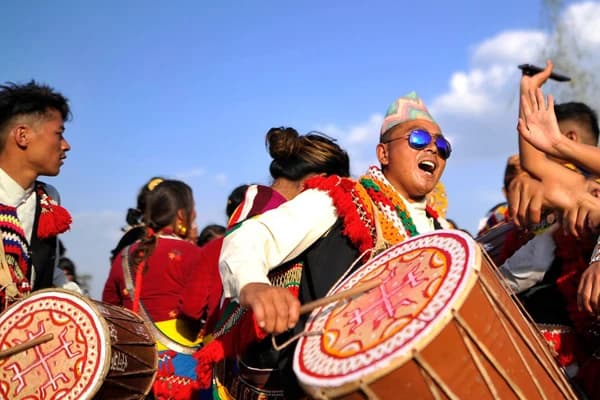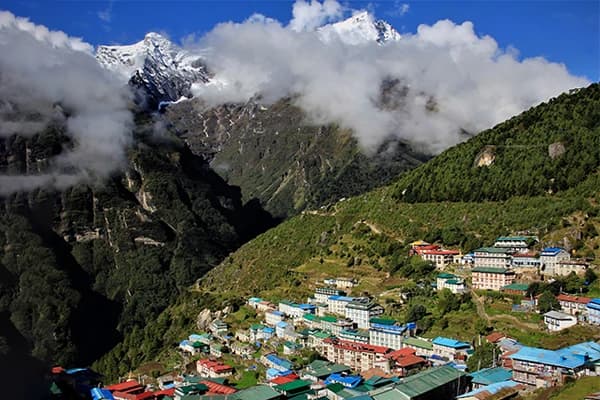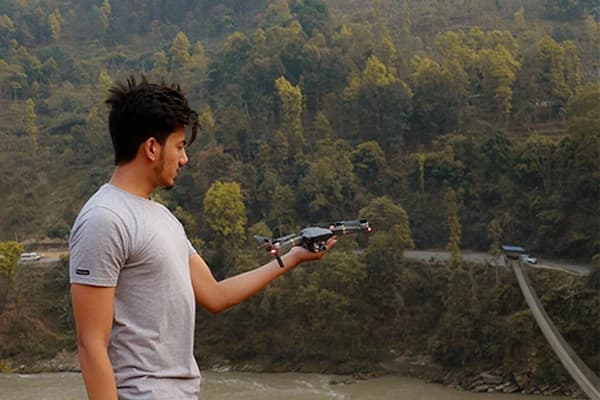Traditional Architecture, Cultural Heritage & Local Lifestyle
Ghandruk village is popular for its distinctive Gurung architecture and lifestyle. The traditional-style houses feature sturdy walls and roofs made of slate and open courtyards. These features are best for the region and also help withstand the winter or the monsoon times.
The village features narrow, winding stone-paved alleys that become pathways for the people and also spaces between the homes. These structures of the homes and the layout of the village reflect the deep cultural roots of the Gurung community and the need for this unique architecture.
Even though there is an effect of modernization on the lives of the locals of the Ghandruk village, cultural heritages of the village still remain preserved in the museums.
The Gurung Cultural Museum, also known as the Old Gurung Museum, is the cultural highlight of the village. The museum displays the traditional costumes and jewelry, musical instruments, historical artifacts, ancient weaponry, photographs, everyday household items and tools, and exhibits on the Gurung people's contributions to the Gorkha Army and their way of life.
Also, the lifestyle of the Gurung community remains rooted in their ancestral cultures and traditions. Most of the people are engaged in subsistence farming, weaving, and handicrafts. Other people are involved in the tourism-related business and honey hunting.
Scenic Beauty and Panoramic Mountain Views
Ghandruk is one of the best places in the Annapurna region to enjoy the views of the snowcapped peaks and surrounding area. From the village, you can see the peaks like Annapurna South. Machhapuchhre, Hiunchuli, Gangapurna, Annapurna I, and so on.
Besides the snowcapped peak views, you can also see the traditional architecture, terraced fields, lush landscapes, and peaceful environment.
You can also see the seasonal variations in the forest around the Ghandruk village. For example, there are rhododendrons and other flowers blooming during the spring season with clear skies. And you can see more snowcaps on the mountains during the winter season.
Festivals & Social Traditions of Ghandruk Village
The cultures and traditions are passed from generations to generations through the festival like tamu lhosar. The traditional music and dances like Ghatu, Sorathi, and Chyau Chyau that reflect the ancient rhythm are performed in the festivals.
During the festival celebrations, people also wear the traditional attire like a bhoto, a jama, a bhaghangra & a kachhad (worn by men), and a Guniu cholo and Patuka (worn by women). These attires are the cultural identity of the Gurung community.
People gather in the communal events like Rodhi and enjoy the singing, dancing, and storytelling. Some sing, some dance, while others enjoy their performances. These are the ancient traditions passed from generation to generation.
Homestays & Authentic Experiences
The Ghandruk village is known for the authentic homestays too. It offers the travelers the opportunity to experience the unique local cultures while staying with the local families and tasting their unique cuisines.
The concept of the homestay is unique but offers several benefits. So, most of the tourists prefer the homestays instead of traditional teahouses. They get to stay with the local Gurung and Magar families, learn their traditions and daily routines firsthand, participate in the traditional activities, and so on.
From the homestays, the tourists also can enjoy the views of the snowcapped peaks like the Annapurna South, Hiunchuli, and Machhapuchhre (Fishtail) mountains.
The meals in the homestays are prepared freshly with locally sourced ingredients. Most of the ingredients are produced in the village. The visitors also get to enjoy the local, homemade Nepali cuisine.
The popular meals of the Ghandruk village are dhindo (millet or buckwheat dough), millet bread (Kodo ko Roti), sel roti, bamboo shoot curry, millet bread (Kodo ko Roti), and yak cheese.
Things to Do in Ghandruk
While in Ghandruk, you can do several things. For example:
- Explore the Gurung Museum and learn about the ancient cultures and traditions.
- Hike to the kimchi, landruk, or jhinu danda for the extra adventure.
- Taste the unique local cuisines made by the Gurungs using the locally produced ingredients.
- Explore the nearby forest and enjoy birdwatching in a peaceful environment.
- Interact with the locals and learn about their lifestyles.
- Enjoy the breathtaking views of the snow-capped mountains.
Ghandruk as a Trekking Gateway to the Annapurna Region
There are several trekking routes that go through the village of Ghandruk. The village provides direct access to the network of hiking trails that lead deeper into the Annapurna Conservation Area. The village is accessible from Pokhara; the trekkers can drive to Nayapul or Kimchi from Pokhara.
It is situated at the perfect altitude level at 2012 m. This altitude level is best for the starting or stopping point for several classic treks, including the annapurna base camp (abc) trek, the ghorepani-poon hill trek, the abc with the tilicho lake trek, and so on.
From the village, the trekkers can enjoy the stunning views of the snowcapped peaks like Annapurna South, Machhapuchhre (Fishtail), and Hiunchuli while resting in the homestays or tea houses.
Travel Tips for Ghandruk
- Pack all the essential items based on the season you are traveling in.
- Carry enough cash with you, as there are no ATMs in Ghandruk.
- Bring the power bank with you, as there may be power cuts in the Annapurna region.
- Drink plenty of water for hydration, especially during the trekking.
- Respect the local customs and traditions.
- Don’t throw waste anywhere. Carry your waste yourself.
- If trekking in the peak trek season, book the accommodations in advance.
- Dress modestly while visiting religious sites.
- Hire a guide for better experiences.
Embracing Ghandruk's Timeless Charm
Ghandruk is a village that offers experiences beyond sightseeing. It is the place where visitors visit to form connections to nature, share experiences, and gain a deeper appreciation for a way of life that balances tradition with adaptation.
As you leave Ghandruk, you will carry with you not just memories, but a newfound respect for the enduring spirit of the Gurung people and the beauty of cultural exchange.
FAQ Section
- How long does it take to reach Ghandruk from Pokhara?
The duration depends upon which mode of transportation you take to reach Ghandruk from Pokhara; the shortest and fastest option is to drive directly to Ghandruk, which requires 3.5 hours of driving. If you take the bus, it may take longer (generally 4 to 5 hours), and it also may require walking a certain distance from the bus drop-off point to Ghandruk.
The other options include driving from Pokhara to Nayapul and then trekking to Ghandruk. It takes around 1.5 hours to reach Nayapul from Pokhara and then around 3-4 hours to reach Ghandruk.
- Do I need a guide or porter?
As Ghandruk is not a restricted area, you don’t need a guide or porter. You can go for independent trekking on this route. However, if you have a guide with you, your experiences can be better, and you can continue the safe journey.
- Is Ghandruk good for families or solo travelers?
Ghandruk is suitable for both families and solo travelers. It is easy to trek, offers cultural immersion opportunities, and can do several activities like nature walks and bird watching, and it offers a chance to experience the warm hospitality best for both families and solo trekkers.
- Are there ATMs in Ghandruk?
No, there are no ATMs in Ghandruk. So, bring enough cash for your travel expenses in the local currency.
Ghandruk isn’t just a village - It’s a cultural moment. Add it to your next trek.





